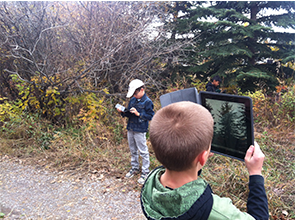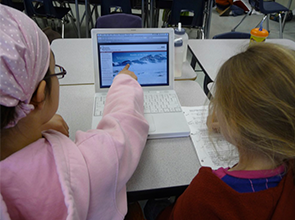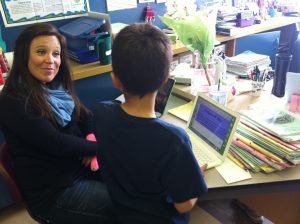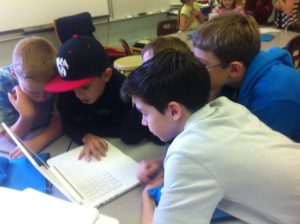
Author(s): Michele Jacobsen
Published in: Education Canada Magazine, Fall 2015, Volume 55, Issue 3

This digital world calls for changed mindsets about schooling, teaching, learning, and assessment – and engaged teaching matters more than ever. Combining inquiry and technology opens the door to powerful new teaching and assessment practices that result in documented benefits for learners. To realize these benefits, teachers need support in making major shifts in their practice: how they work with disciplinary knowledge, how they design for learning and assessment, and how they embrace technology. It is time for top-down approaches to schooling to give way to the active, engaged, and collaborative teaching and learning relationships made possible by new educational technologies. But how do we provide rich and meaningful professional learning opportunities that engage teachers in making the shifts that are required of them in blended and open participatory digital classrooms? How do we help them prepare young people to make the most of the technologies at their fingertips?
Social networking, cloud-based computing, and mobile technologies are transforming how people learn, work, and play. Digital technology has evolved quickly from personal computers and networks to participatory social, academic, and political Web 2.0 environments with a new vocabulary and new temporal and spatial interactions. Web 2.0 applications – Safari, Geocaching, Flickr, Google, Blogger, GarageBand, Wikipedia, YouTube, iMovie, Facebook, Twitter, iPhone, and iPad – are part of a new user-centric information infrastructure that emphasizes creative participation over presentation; encourages focused conversation and short briefs written in less technical, public vernacular; and facilitates innovative explorations, experimentations, and purposeful tinkerings that often form the basis of situated understanding that emerges from action not passivity1
This digital world calls for changed mindsets about schooling, teaching, learning, and assessment. Teachers – who are often more comfortable with broadcast and interactive technologies – are now expected to embrace online participatory learning technologies in support of active, passion-based learning by students who live and will work in a digital world. These teachers need support in making major shifts in their practice: how they work with disciplinary knowledge, how they design for learning and assessment, and how they embrace technology. It is time for top-down approaches to schooling to give way to the active, engaged, and collaborative teaching and learning relationships made possible by new educational technologies.
In this digital world, engaged teaching matters more than ever. Combining inquiry and technology opens the door to powerful new teaching and assessment practices that result in documented benefits for learners2. But how do we provide rich and meaningful professional learning opportunities that engage teachers in making the shifts that are required of them in blended and open participatory digital classrooms? How do we help them prepare young people to make the most of the technologies at their fingertips?
A Shifting Digital World
The world of work has changed3. Technological advances – along with always-available, always-connected personal mobile devices – are enabling corporate communities of practice in which colleagues share experiences, reflections, and insights in a continuous dialogue, unleashed from the four walls of an office or the hours of a standard workday. These 24/7 asynchronous communication capabilities allow corporate knowledge workers to take control of the workday and extend collaborations online in ways that significantly change how 21st century work is conceived, conducted, and completed.
“The most powerful thing teachers do to engage students is to design engaging, meaningful, and authentic work and technology-enhanced learning experiences.”
If work is now about networking, question-posing, critical assessment of information and media, collaborative team work, and creating new knowledge and ideas, then today’s students require opportunities to develop the competencies they need for expert adult performance in digitally rich and net-connected school spaces.
Young people are already connected and resourceful; they use personal technology in creative, entertaining, and collaborative ways. But to go beyond facts and procedures, they need engaged and skilled teachers to guide and mentor them towards the deeper conceptual understandings and core competencies that allow them to reason about real-world problems, critically analyze information, and engage successfully in 21st century work.
Teaching and Learning in the Digital Age

The most powerful thing teachers do to engage students is to design engaging, meaningful, and authentic work and technology-enhanced learning experiences. In other words, teaching matters. Research on engagement indicates that teachers have a greater effect on students’ learning outcomes than the schools they attend; this holds true at both the elementary and secondary levels4. In order to improve learning in a digital world, we need engaged teachers who are supported by professional learning opportunities to continually improve and strengthen their digital competencies and their teaching and assessment practices.
Engaged teachers and engaged students go hand in hand. Research has shown us that engaged teaching practices can enable all students to achieve at high levels and that students have better educational experiences when teachers and students actively collaborate in the process of knowledge building and idea improvement5. We know that certain teaching practices and learning processes engage students and teachers in deeper and more sustained learning by connecting them with knowledge and technology in ways that make a difference to themselves and to others.
In 21st century learning spaces, students can become engaged in challenging work that has value beyond the classroom – in authentic, inquiry-based tasks that captivate their hearts and minds. The many benefits – for both students and teachers – of learning in such contexts, using technology in appropriate and innovative ways, have been well documented. Strong discipline-based inquiry work exhibits a number of very discernible characteristics, including academic rigour, authenticity, assessment that is deliberately woven into the work, digital technology that is used in purposeful and authentic ways, connections with experts beyond the school, constructivist approaches to learning, and relevance beyond the classroom. From a longitudinal study at a “1-2-1 laptop” school, student work demonstrating deep understanding of sophisticated concepts emerged from discipline-based inquiry tasks that were intentionally designed with clearly defined criteria in mind6.
But students cannot develop deeper conceptual understanding simply from teachers instructing them better. Learning sciences research has demonstrated that only active participation in knowledge construction allows for deeper conceptual understanding of disciplinary concepts and increased motivation for learning7. Teachers who engage students in authentic tasks intentionally design active learning opportunities that are similar to the everyday activities of professionals who work in a discipline. By combining these tasks with appropriate technology, students are able to represent their learning in a variety of ways that provide teachers with greater insight into the depth and extent of their understanding.
Reflection on learning is important, both for students and for teachers, and this, too, can be enhanced by appropriate uses of interactive technologies. Students learn better when they express their developing knowledge – either through conversation, or by creating written assignments, media artifacts, or visual messages – and are provided with opportunities to reflectively analyze their state of knowledge. Research has also demonstrated that the more opportunities teachers have to work collaboratively with colleagues and professional development experts, to engage in professional dialogue about teaching and learning, and to make their work public, the more engaged they become in inquiring into and strengthening their own practices8.
“Outside of formal schooling, almost all learning occurs in complex social environments…Teachers who design for peer collaboration and individual reflection on learning cultivate stronger learning outcomes.”
Worthwhile and academically rigorous work requires students to use their minds well and to demonstrate innovation, problem-solving, and reasoned judgment. Digital learners use multiple media forms and Web 2.0 outlets to share their work beyond the classroom. When student inquiry projects focus on enduring ideas from within the disciplines and on knowledge building and elaborative communication versus individual memorization and recall, then the appropriate use of technology helps learners to think differently and to gain deeper understanding.
Effective Social Learning Online
Outside of formal schooling, almost all learning occurs in complex social environments9. When online learners have more control of their learning and participate in active or interactive learning experiences such as collaborative, project-based learning tasks, larger learning gains are observed10. Complex social environments and interactions can clearly be cultivated online. The thoughtful design of meaningful online learning experiences matters; teachers who design for peer collaboration and individual reflection on learning cultivate stronger learning outcomes.
Barbara Means, a leader in evaluating technology-supported educational innovations, led a team of researchers to study evidence-based practices in online learning11. A meta-analysis of more than 175 studies found that online learning or blended learning conditions produced stronger learning outcomes than did classes with solely face-to-face instruction. The combination of additional learning time, rich online materials, and additional opportunities for collaboration produced the observed learning advantages.
Means’ study also showed that teaching and the design of meaningful learning tasks matter more than the particular online technologies used to promote interaction, reflection, and active learning. That said, online learning experiences were more likely to be student-directed, interactive, and collaborative in nature than teacher-directed. The perfect blend appears to involve greater time-on-task for students, with access to rich, interactive curriculum materials – such as online simulations, digital experiments and data collection sites, online reflection tools, and self-assessment strategies.
At its best, then, online learning combines the benefits of digitally available content with a responsive teacher and student peer groups to support the kind of interaction, collaboration, and discourse that builds higher-order critical thinking skills. When educators blend the best features of in-class teaching with the best features of online learning, they promote active, self-directed, and flexible learning opportunities that are supported with appropriate digital technologies.
John Seely Brown and Richard Adler describe the growth and expansion of the Internet as brewing the perfect storm of opportunity for education12, providing online access to high-quality tools like scanning electron microscopes and supercomputer simulation models that allow students to engage personally in research and that foster a new culture of sharing in which content is freely contributed and distributed. The evolution of Web 2.0 is blurring the line between producers and consumers of content and shifting attention from access to information to access to other people, and online experiences and virtual communities like Second Life are allowing people with common interests to meet, share ideas, and collaborate in innovative ways.
The greatest educational benefit of online social learning and Web 2.0 technologies is putting students in touch with each other. Social learning is based on the premise that our understanding of content is socially constructed through conversations and through interactions, especially with others, around problems or actions. Collaborative online social learning opportunities increase peer interaction and access to each other’s ideas, experiences, and knowledge; it offers more opportunities for students to find and join niche communities where they can benefit from the opportunities for distributed cognitive apprenticeship; and it goes beyond providing access to traditional course materials and educational tools to create a participatory architecture for supporting communities of learners13. In the hands of a skilled teacher, these tools can be used to cultivate lively debate and exchange of ideas, support the social construction of knowledge, and democratize the classroom.
In order for educators to leverage Web 2.0 and social learning opportunities, they need unrestricted and unfiltered access to online communities and resources using reliable, mobile, and powerful devices and networks. It is the responsibility of school jurisdictions to design and maintain robust school networks that are open to student-owned devices, and to trust principals, teachers, and students to use the Internet critically and ethically rather than filtering and firewalling access to open participatory ecosystems.
Ongoing Professional Learning in A Digital World

Theories of knowledge, learning, teaching, and technology are shifting. Knowledge is more than storage; it is socially constructed and shared. Learning is more than memorization and recall; it is an active, situated, and engaged process of making meaning, interpretation, and developing deep understanding. Teaching is more than information delivery; engaged teaching involves the design and support of rich learning experiences. Technology is more than a tool; it supports deep and engaged learning, simultaneous articulation, creation, and reflection in participatory social networks and dynamic ecosystems. Teachers who have spent an entire career mastering the skills required to manage a 20th century classroom need support to design 21st century social learning approaches in participatory Web 2.0 environments.
We cannot shut down the education system while teachers retool their practices and jurisdictions bring technological infrastructures up to standard. Even if we could, simply training teachers in the use of current technologies will not promote the engaged and active learning we need. Instead, teachers need continuous professional support while they learn to design rich, authentic learning tasks and support the evolving needs of their students. Teachers as well as students learn by engaging in meaningful design work; by studying, doing, experimenting, and reflecting; by collaborating and conversing with peers; by sharing what they see, do, and create with others. In order to understand how to effectively design learning that uses technology to increase student engagement, teachers need opportunities to engage and learn in similar ways themselves, and subject their learning to peer review and critique.
High quality, blended professional learning experiences that transform teaching practices do exist14. The Galileo Network is a participatory learning ecosystem that engages teachers in scholarly communities of inquiry, along with their teaching colleagues, to transform their practices for a digital world. Working collaboratively, face-to-face, and online with over 2,000 teachers, 200 school administrators, 300 district level professional development providers, and 50 district administrators, Galileo mentors and researchers have been able to create robust research and images of practice for 21st century learning, teaching, and leading15. It also provides an online showcase of successful case studies.
Galileo mentors cultivate 21st century practices by working alongside teachers who are dedicated to improving student learning through engaging in professional learning while conducting and applying research.
Through this network, teachers become active members in scholarly communities of inquiry in which their teaching practices are shared publicly, open to discussion and critique, and subject to continual improvement. Partnerships between the University of Calgary, schools, and the Galileo Network provide rich opportunities for inquiry and digital apprenticeship of student teachers16. Student teachers observe how classroom teachers design and support inquiry projects for students, and design their own tasks and authentic assessment strategies. In the company of their teaching colleagues, student teachers implement their project and task ideas with students and engage in professional dialogue about what is working well, what needs to change, and what their next teaching steps must be in order to support student learning.
Conclusion

Investments in high quality professional learning opportunities to support teachers in designing meaningful, highly engaging, blended learning experiences for students do pay off. Professional dialogue and learning opportunities for a digital world need to be designed and led by professional mentors, teaching colleagues, and school leaders who model 21st century teaching and learning practices.
Teachers matter more than ever, and the education system needs to be held accountable for the teaching that is practiced in the current technology-rich environment. Principals must engage in continuous professional learning to understand the changes required for 21st century teaching and learning. School jurisdictions must put powerful digital technologies in the hands of every student and teacher, and trust them to use open and secure networks and resources well. Faculties of education need to provide rich and meaningful ongoing learning opportunities for both pre-service and inservice teachers. Provincial ministries need to resource ongoing and appropriate professional development for teachers and deploy innovative and creative solutions for technological resources and infrastructure. Educational stakeholders must work together, learn together, design and evaluate student understanding and learning together, and leverage each other’s best practices to imagine and to create context-specific ideas, practices, and solutions that are flexible and responsive to the diverse learners that each school serves in open participatory learning ecosystems.
- J. Seely Brown and R. P. Adler, “Minds on Fire: Open Education, the Long Tail, and Learning 2.0,” EDUCAUSE Review 43, no. 1 (January/February 2008): 16–32.
- M. Jacobsen, Learning Technology in Continuing Professional Development: The Galileo Network (Lewiston, New York: The Edwin Mellen Press, 2006); M. Jacobsen, C. Saar, and S. Friesen, “Teaching and Learning in a One-To-One Personalized Computing Environment Year Three: A Research Report on the Personalized Learning Initiative at Calgary Science School.” 2010.
- M. Bjerede, K. Atkins, and C. Dede, “Ubiquitious Mobile Technologies and the Transformation of Schooling,” Educational Technology 50, no. 2 (2010): 3-7.
- J. D. Willms, S. Friesen, and P. Milton, What did you do in school today? Transforming Classrooms Through Social, Academic and Intellectual Engagement, First National Report (Toronto: Canadian Education Association, 2009). Available at www.cea-ace.ca/whatdidyoudoinschooltoday
- Ibid.
- Jacobsen, Saar, and Friesen.
- R. K. Sawyer, ed., The Cambridge Handbook of the Learning Sciences (New York, NY: Cambridge University Press, 2006).
- Jacobsen, Saar, and Friesen.
- Sawyer.
- B. Means, Y. Toyama, R. Murphy, M. Bakia, and K. Jones, Evaluation of Evidence-Based Practices in Online Learning: A Meta-analysis and Review of Online Learning Studies (Washington, D.C.: U.S. Department of Education, Office of Planning, Evaluation, and Policy Development, 2009). Available at www.ed.gov/about/offices/list/opepd/ppss/reports.html
- Ibid.
- Brown and Adler.
- Ibid.
- Jacobsen, 2006.
- Ibid.; S. Friesen, “Galileo Educational Network: Creating, Researching and Supporting 21st Century Learning,” Education Canada 49, no. 5 (2009): 7-9.
- M. Jacobsen, “Creating Inquiry in the Classroom: Preservice Teachers Learn with Students,” Inquiring Minds 3, no. 2 (2010). Available at www.galileo.org/about/vol2issue3.pdf
